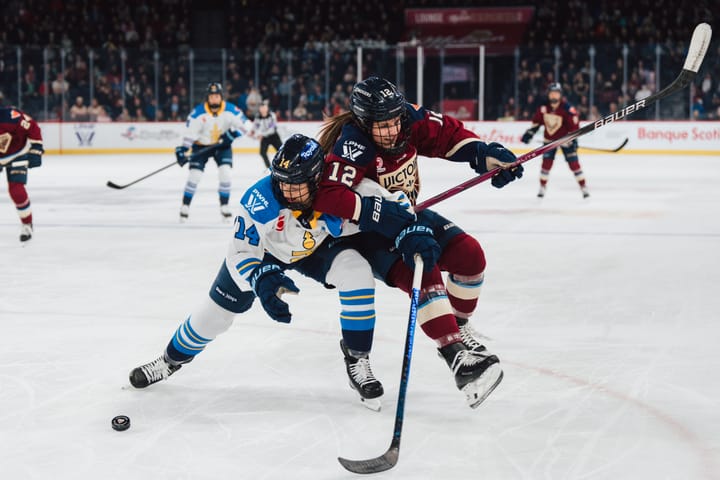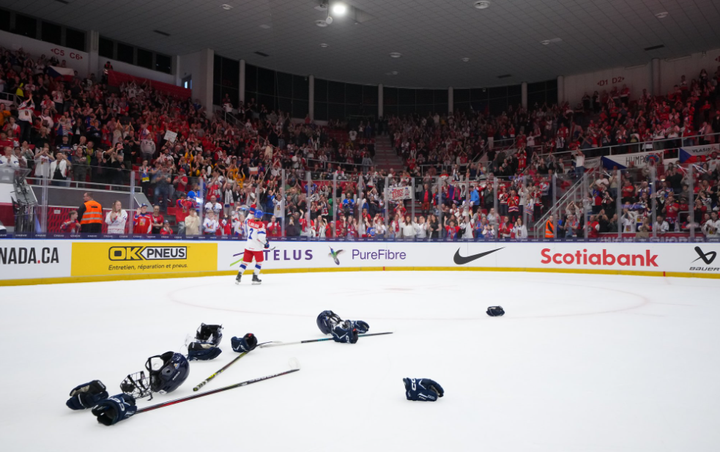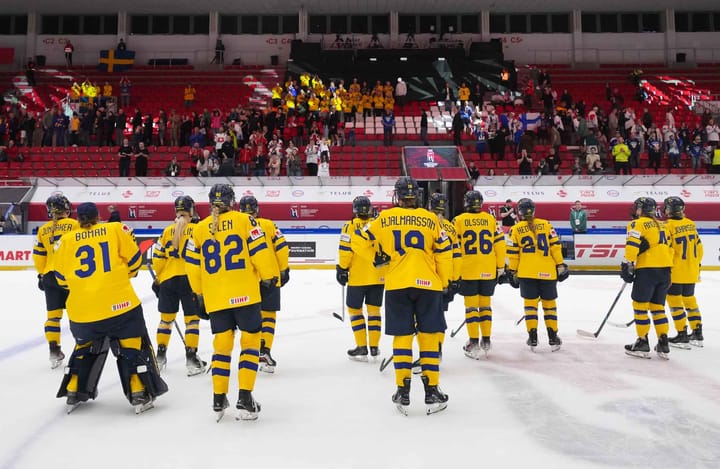NCAA Year In Review: Harvard, Quinnipiac, RPI, St. Lawrence
The lower seeds in the ECAC all had their seasons end on the same weekend
As the NCAA women’s hockey season winds down, writers William Whyte and Gabriella Fundaro are taking an in-depth look at how each team has shaped up in 2018-19. In this post, we break down teams 5-8 in the ECAC, all of whom lost in the quarterfinals.
Harvard
Gabriella: The Crimson put up a good fight in the first round of the ECAC playoffs, pushing second-seeded Colgate to a game three, but were eventually bounced in that deciding game to close out their season. Overall, it seems like Harvard was able to build off of last season, when the team returned to the ECAC playoffs. They didn’t see a ton of improvements offensively, though it’s clear they’re getting better there, too, thanks to their underclassmen. Instead, Harvard was really bolstered by the play of Lindsay Reed in net, yielding just 2.12 goals per game.
The Crimson finished the year with a losing record, at 12-15-5, but it was clear all season they weren’t a team to take lightly. A win over BC and back-to-back overtime losses to Wisconsin are proof of that. What did you like about Harvard this season, and how do you see them continuing to improve for next year?
William: The best stat from Harvard’s season was that although they were 4-6-2 before Christmas, every single loss was by only one goal, including losses to Cornell and Colgate and the two games against Wisconsin. After a disappointing 1-5-1 January, including a 6-0 loss to Cornell, they had an amazing February where they went 6-2-2, beat BC in the first round of the Beanpot, and took both the Beanpot final and their second regular season game against Clarkson to overtime. So the season ended well, and the Harvard games I saw at the end of the season were high energy, and they’ve locked down the defensive end -- they gave up 68 goals this year, 20(!) less than last year. For next year they need to work on scoring. They scored five fewer goals this year than last year, and that’s not going to get them up to home ice in the ECAC tournament. With St. Lawrence struggling, RPI losing Selander, and Quinnipiac without an identity, Harvard could be the team that pushes Colgate out of ECAC fourth place. But probably in two years’ time.
Stick taps: The freshmen. Lindsay Reed obviously goes without saying, but Kristin Della Roviere has a been a points leader for the team and USA U18 captain Dominique Petrie, though she missed some games due to injury and maybe isn’t scoring as heavily as expected, is already a leader on the ice. You can broaden this to the underclassmen in general -- Sophomore Brooke Jovanovich is only fifth in scoring on the team, but every time I see her on the ice her compete level is off the charts.
Losing an edge: After putting up a fight all season against stronger opponents, going winless in the final two games before playoffs against Brown and Yale had to be a little disappointing for the Crimson.
Quinnipiac
William: Quinnipiac had a frustrating season. They have seven alums of the Canadian or US U-18 national team, which I believe is in the top eight of schools nationwide, and also have UND refugee and Finnish National Team player Anna Kilponen. Four of those U-18s are freshmen, positioning the program strongly to build for the future. Quinnipiac has traditionally been a team that’s been good at following a coach’s systems, especially defensively, and has punched above its weight in the ECAC as a result. This should have been a good year for them. And yet they went 12-18-6, scored four goals in a game only once in 2018, and don’t have a single victory over a team with a win record over .5. Last season they had wins over Clarkson and Cornell; and of course two seasons before that they went 30-3-5, won the ECAC, and made the national tournament for the first time. It really feels like third-year head coach Cassandra Turner isn’t connecting with the team. What’s going on in Hamden?
Gabriella: Defensively, I don’t think the Bobcats had a problem when it came to executing their system. They gave up an average of 2.03 goals per game, and held their opponents to just 25.33 shots on goal per game, too. They weren’t awful at getting shots either, but as a team, they shot just 7.1% on the year, which explains in part why goals were hard to come by. It surprises me, too, because I think Quinnipiac had one of the best-looking top-six units on paper going into the year, but they did not do enough to score consistently. Their top line of Melissa Samoskevich, Randi Marcon, and Kenzie Lancaster all graduate, too, so it could get even harder for them to find offense moving forward.
Stick taps: After the New Year, Quinnipiac turned it around a bit. They had four goals or more in a stretch of four out of five games; they got a win over Minnesota-Duluth, though this wasn’t as big as it seemed it might be at the start of the season; and they played Clarkson hard in three of the four games the two had between February 1st and March 2nd. And they were the last Connecticut team to have their season end, though only an hour and 29 minutes after UConn’s did.
Losing an edge: The offense.
RPI
Gabriella: The Engineers recorded their most wins (14) since the 2008-09 season, when they had 16, so there are definitely things for this team to be proud about. First and foremost: Lovisa Selander, who regularly stockpiled 40, 50, and 60 saves a night to push her team into the win column against top opponents. Unfortunately for RPI, Selander is a senior, so she won’t be back next year to give them that huge boost in net. They certainly made things interesting in the ECAC for as long as it lasted this season, and it’s a little bit of a shame they couldn’t continue on in the playoffs and advance to the ECAC semifinals. Are there any other recent teams that come to your mind who also played spoiler for top competition, and what can the Engineers learn from them as they fight to maintain a playoff spot for next year?
William: I think recent-years’ Bemidji are also a classic spoiler team, with more firepower up front; or, from Hockey East’s point of view, last year’s Connecticut (if you’re BC) or Merrimack (if you’re Minnesota). The thing they all have in common, of course, is excellent goaltending. For RPI, next year’s goaltending is a complete unknown: backup goalie Kira Bombay, who posted a respectable .935 save percentage across six games, is also a senior, and sophomore Jenn Gregg hasn’t played a single minute in her college career. RPI are going to have to hope she’s a hidden gem if they’re going to match this year’s success next season. Up front, Blake Orosz has emerged as a genuine scorer going into her senior year, but RPI had better hope the freshman class provides her some support.
Stick taps: Lovisa Selander became the NCAA’s all-time saves leader, finishing with 4,167 in her career. She also became the first Engineer in program history to be named a Patty Kazmaier top-10 finalist.
Losing an edge: 50 goals for all season? 1.35 goals for per game, more than only Union, Dartmouth and Holy Cross? Really?
Selander Named #ECACHockey Goalie of the Year Finalist #RPIHockey https://t.co/anG3dnOOXJ
— RPI Athletics (@RPIAthletics) March 4, 2019
St. Lawrence
Gabriella: Though they had some big wins against ECAC opponents, this was the first time since 2013-14 that St. Lawrence did not reach the .500 mark, finishing with a record of 14-15-7. Organized play defensively, with a certain scrappiness on the counter, were continued bright spots for the Saints. Those efforts were led by an excellent penalty kill that ticked at 87.8%. Seniors Grace Harrison and Sonjia Shelly continued to split time in net, though Harrison saw the bulk of the starts; she posted a fairly average .922 save percentage on the year. I think the Saints may have needed to see some truly standout performances in goal considering how much their offense dropped off. With players Kennedy Marchment and Hannah Miller departing, they managed just 2.11 goals per game.
From what I saw of St. Lawrence this season, their squad as a whole was competitive and consistently pushed their opponents. But they weren’t able to produce any high-level individual success from that. Do you think there was a clear talent drop-off this season that led to that? Or could it also be a result of their game plan, and trying to be a well-rounded team first and foremost?
William: Something went terribly wrong with St. Lawrence’s offense this year -- they dropped from 3.19 goals a game two years ago, when they managed an at-large place in the NCAA tournament, to 2.11 as you note. Even more striking, in 2016-17 they were in fifth place in goals for per game; this year they’re in 23rd of the 35 “proper” D1 schools. Behind Yale! Behind Lindenwood! It feels like there’s been an exodus of top-end scoring talent and that, in combination with that, coach Chris Wells hasn’t been able to adjust the systems quickly enough to accommodate the change from a high-shooting, high-scoring team to one that’s by necessity going to be defense first. Without a change in recruiting or a wholesale change and buy-in for a new style of play, St. Lawrence is at risk of becoming an ECAC tournament bubble team, helped only by the fact that teams below it in the ECAC aren’t improving. Next year could be a big one for them.
Stick taps: St. Lawrence had one of the most memorably weird weekends this season in their January 11-12 series against RPI and Union. Full details are in this fantasy post (see “St. Lawrence’s weird weekend”). The highlight was when St Lawrence tried to play their fourth(!) goalie in the Union game and took a penalty for “illegal lineup”, which is a penalty that has only been given out one other time in the last ten years… which was also on St. Lawrence. Props to St. Lawrence for keeping it strange.
Losing an edge: The opposite of props is ANTIPROPS, and St. Lawrence deserves particular ANTIPROPS for how it’s managed communications this year. There was no post introducing the freshmen; the full team roster was posted literally four days before the first game; the men’s team provide decent live Twitter coverage of their games, the women’s team don’t even have an account. In a season where a lot of schools significantly improved their social media game, you can’t see this helping St. Lawrence distinguish itself in its recruiting battles. Do better, St. Lawrence!
This is the men's hockey team account...
— St. Lawrence Hockey (@SkatingSaints) February 9, 2019
But we can tell you it's 1-1 at the end of two in the women's game in Canton.





Comments ()